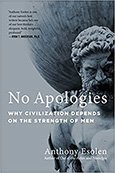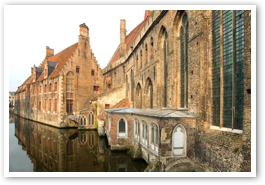The Church has always built hospitals
- ANTHONY ESOLEN
Why were there no hospitals, for anyone and everyone, in the ancient world? Because Jesus had yet to give mankind, through his Church, the great directive.
Join the worldwide Magnificat family by subscribing now: Your prayer life will never be the same!
One day, as Jesus was entering Capernaum in Galilee, a Roman centurion sent for him, and pleaded with him to heal his dying servant whom he dearly loved.
The Jewish elders joined in the plea, because this centurion was a friend of the Jews. He may have been, in his heart, a convert to the faith in the one God. "He loves our nation," they said, "and has built a synagogue for us!" Seeming to take no note of that reason, Jesus approaches the centurion's house, but the centurion, abashed because he knows that he is a pagan and a sinner, says, "Lord, I am not worthy that you should enter under my roof, but only say the word, and my servant shall be healed."
Jesus marvels, saying, "I have not found such faith in all of Israel!" And the servant was healed from that moment.
But the scene prompts a question. The centurion is rich enough to build a synagogue at his own expense. He lives in the bustling town of Capernaum, on the north shore of the Sea of Galilee; and the new Roman city of Caesarea Philippi is not far away. Why hasn't he brought his servant to the hospital?
You will answer, "Because there were no hospitals in those days," and you will be right, in part. There were health resorts, often built up around natural hot springs in those lands perched atop the volcanic ring of fire. Wherever the Romans found hot springs, they built resorts, even as far north as England: Bath. But there was no such thing as a hospital, where you could go if you were ill and needed care and were not rich enough to get to the spas, and had no money to hire the learned physicians. Apparently there was nowhere to go in Capernaum, even for a centurion with means.
And that prompts another question: "Why were there no hospitals?" It cannot be for want of funds. The Romans were energetic at public works, and when their armies were not busy fighting, they were employed as a corps of engineers and construction workers, building aqueducts, theaters, the civic halls we know as basilicas, temples, roads, and bridges. They could have built hospitals also. Nor was it for want of medical knowledge. The Greeks had learned medicine from the traditions of the Egyptians, whose accumulated knowledge spanned two thousand years. The Greek Hippocrates had bequeathed to the world the oath that bears his name, enjoining a sacred code upon all physicians. "The art takes a long time to learn," said Hippocrates, "and life is short." Those are not the words of a quack.
So why were there no hospitals, for anyone and everyone? Because Jesus had yet to give mankind, through his Church, the great directive. "I was sick, and you visited me," says the Lord at the final judgment, and when the righteous reply, "But Lord, we never saw you sick," the answer comes, "Whatsoever you do to the least of these my brothers, the same have you done unto me." Every human being is of inestimable worth; not because he is rich or powerful, or dear to someone who is rich or powerful. Christians are commanded to see in the face of every human being the face of their brother — the face of Jesus. That transforms the world.
Christians are commanded to see in the face of every human being the face of their brother — the face of Jesus. That transforms the world.
What do we suppose the Christians built, soon after Constantine issued the Edict of Milan in 314, legalizing Christian worship throughout the Roman Empire? They built churches, of course; and hospitals were not far behind. Saint Basil, the great theologian and bishop of Cappadocia, founded an enormous complex of buildings and streets just outside of his city of Caesarea for the care of the sick. It was so large, it came to be called the New Town. There were buildings for different kinds of patients, a home for infants, a home for the aged, and a lazaretto for people afflicted with contagious diseases. There were dwellings for physicians and nurses, so they could be always near the people they were treating. There were even workshops and schools where men crippled by disease or injury might learn a trade, to support themselves and their families.
It wasn't the only such place. In Constantinople alone, during the reign of Justinian, there were thirty-five hospital foundations. In the Middle Ages, religious orders were established, such as the Knights Hospitalers of Saint John, whose vocation was to care for strangers and pilgrims and the sick. Wherever they went, they were bound by vow to build a hospital. When, in the thirteenth century, town life returned to Europe with great vigor (for the Vikings and other Germanic and Slavic pagans had been converted to Christianity, and no longer made life on the borderlands or on the seacoasts precarious), new hospitals were founded everywhere, so that in Germany every small town of five thousand persons had its hospital. Pope Innocent III himself commissioned the construction of the Santo Spirito hospital, near the Vatican, hiring a hospital architect from France to do the job; and when bishops from other parts of the world came to the Vatican, Innocent urged them to visit the Santo Spirito and to go back home and build hospitals on that model.
And that prompts still another question: "What was the model for a hospital?" We are apt to think that the places must have been dim, miserable, and filthy, where nobody but beggars and desperate men would go. Such is the residue of the prejudice against the Middle Ages engrained in us, who are instructed to fall in worship of new things because they are new.
There's no doubt that medical science can accomplish things that would stun the beholder with wonder — not just a medieval man, but even someone from the days of our grandparents. But that's no reason to suppose that the Church did not do her utmost, in the hospitals, to cure disease, and to comfort the dying, according to the best medical knowledge then available. And more: in some ways the hospitals the Church built were superior to ours.
Sometimes I believe that the evil attraction to euthanasia arises from a natural horror of hospitals such as they are. When my wife's mother was dying, we stayed with her at the hospital for several days, in the white sterile impersonal room, hearing the blips of the machines, the drone of the television, and the calls on the intercom. The doctors and nurses were quite efficient — one might say, coldly and mechanically efficient. Of course, since she was going to die, they wanted her to do it as soon as possible, with as little trouble as possible to anybody else, and to that effect they wanted to prescribe morphine, even though she was in no pain. We told them to keep their morphine to themselves. After a few days, though they did not need the bed, and though it could only harm my mother-in-law, they ordered her removed to a local hospice, where she soon died.
It is hard for us to imagine, but the Church built hospitals that were beautiful. Well, these were medieval men, who had not yet acquired the modern knack of building things intended to be ugly; every chance they had, they surrounded themselves with things of beauty. But they also believed that a sick or dying person above all should be comforted with beauty. They built lovely hospitals, usually outside of the town walls, for fresher air. It was the custom, says Dr. James Walsh in The World's Debt to the Catholic Church, "to decorate the hospitals with beautiful frescoes and the result was that patients had much more occupation of mind than they have in our bare walled hospitals." Imagine that you are lying on the bed from which you will not rise, and seeing, near to you in more ways than one, a painting of The Mystical Marriage of Saint Catherine, with the Christ Child enthroned in the bosom of Mary, placing a golden ring upon the finger of that young saint who suffered so much in her body as she prayed and labored for the welfare of the Church.
I'm not making that up. That is what you might have seen if you lay in the Hospital of Saint John, in Bruges. And it was no local child they hired to decorate the walls with some garish cartoon. It was the exquisite Hans Memmling, who knew how to make the countenance of a holy woman like that of a queen. If you were not in Bruges, but in the Hospital of Charity in Seville, you would have seen the work of Murillo, the kindly and gentle genius. Perhaps you'd have seen his Return of the Prodigal Son, with the old father embracing the poor bedraggled lad, while a small white dog, tail held high, leaps up to greet him.
For the Christians who built these hospitals never forgot that man has a soul as well as a body, and that he longs to leave his bed of illness to return to one home, or to another.
 This is J. Fraser Field, Founder of CERC. I hope you appreciated this piece. We curate these articles especially for believers like you.
This is J. Fraser Field, Founder of CERC. I hope you appreciated this piece. We curate these articles especially for believers like you.
Please show your appreciation by making a $3 donation. CERC is entirely reader supported.

Acknowledgement
 Anthony Esolen. "How the Church Has Changed the World: The Church has always built hospitals." Magnificat (June, 2014): 217-221.
Anthony Esolen. "How the Church Has Changed the World: The Church has always built hospitals." Magnificat (June, 2014): 217-221.
Join the worldwide Magnificat family by subscribing now: Your prayer life will never be the same!
To read Professor Esolen's work each month in Magnificat, along with daily Mass texts, other fine essays, art commentaries, meditations, and daily prayers inspired by the Liturgy of the Hours, visit www.magnificat.com to subscribe or to request a complimentary copy.
The Author

Anthony Esolen is writer-in-residence at Magdalen College of the Liberal Arts and serves on the Catholic Resource Education Center's advisory board. His newest book is "No Apologies: Why Civilization Depends on the Strength of Men." You can read his new Substack magazine at Word and Song, which in addition to free content will have podcasts and poetry readings for subscribers.
Copyright © 2014 Magnificat


